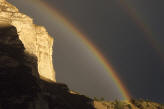Animal life and activity in
Denali is dictated by the seasons. Winter is the longest season and the
animals that are year-round residents are well-adapted to life in the
subarctic. The brief spring season brings the return of 80% of Denali’s
bird life, the waking of hibernating bears, and an increase in activity
levels of wildlife. Summer is a time for raising young and preparing for
migration, hibernation, or survival during the winter. Summer also brings
hordes of insects, including mosquitoes. In late summer king and chum
salmon run in the multitude of streams and rivers. In autumn, migrating
birds fill the skies and bull moose gather their harems of cows for the
mating season.
Year-round residents include all the mammals,
fish, about 18 species of birds, and the one lone amphibian, the wood
frog. Mammals survive the long subarctic winters in many ways. Some
species like grizzly bears and arctic ground squirrels hibernate. Other
species like mice and voles live under the snow in tunnels and burrows.
Caribou, Dall’s sheep, and moose are active throughout the winter and are
constantly on the move searching for food and evading predators. Wolves
are also active year-round, and like their prey, are constantly moving in
search of food. Full time resident birds such as gyrfalcons, ptarmigan,
black-capped and boreal chickadees, and redpolls are efficient at finding
food and conserving energy.
Subsistence hunting is permitted in the 1980 land
additions to the park, and sport hunting is permitted in the preserve
portions of Denali. Local people harvest many different species of animals
for food including moose, ptarmigan, grouse, and fish. They also harvest
fox, marten, lynx, wolverine, beaver, and wolves for their fur.
For many years, scientific interest in Denali
centered on the large mammals because the park’s status as a game refuge
offered scientists the unique opportunity to study the life histories of
unhunted animal populations. More recently, Denali offers scientists a
living laboratory to study how animals respond to changes in their
environment in a naturally fragmented ecosystem.
Denali’s animals are well-adapted to life in the
subarctic. We expect that some populations of animals in Denali will be
significantly affected by global climate change. Climate change impacts
are predicted to be greater in the high latitudes of North America and
exaggerated in the mountainous regions due to a combination of rugged
topography, low sun angle, strong seasonal differences in solar radiation,
and extreme ecological zonation in relation to altitude. Further, the
frequency and extent of chaotic weather events are expected to increase
with climate change. Denali offers scientists and the public opportunities
to learn how animals respond to these and other changes in their
environment.

